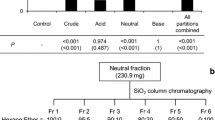Abstract
Chromatograms of the cuticular lipids washed from recently emerged female and maleFannia canicularis (L.) flies were nearly identical, but by the time the flies were 5 days old, the cuticular components of the two sexes differed considerably. A monoolefin which constituted 66% of the cuticular lipid from 5-day-old females stimulated a copulatory response from males and was identified as (Z)-9-pentacosene. The cuticular lipid of the same age males contained only 1% of this compound. Although all the major constituents of the cuticular lipid from mature females were hydrocarbons, 27% of the lipid washed from 5-day-old males was a nonhydrocarbon material that was represented by a single GLC peak. This material was identified as heneicosan-8-ol acetate.
Similar content being viewed by others
References
Axtell, R.C. 1970. Integrated fly-control program for caged poultry houses.J. Econ. Entomol. 63:400–405.
Beroza, M., andBierl, B.A. 1967. Rapid determination of olefin position in organic compounds in microgram range by ozonolysis and gas chromatography.Anal. Chem. 39:1131–1135.
Carlson, D.A., Mayer, M.S., Silhacek, D.L., James, J.D., Beroza, M., andBierl, B.A. 1971. Sex attractant pheromone of the house fly: Isolation, identification, and synthesis.Science 174:76–78.
Chaudhury, M.F.B., Ball, H.J., andJones, C.M. 1972. A sex pheromone of the female face fly,Musca autumnalis, and its role in sexual behavior.Ann. Entomol. Soc. Am. 65:607–612.
Field, F.H. 1970. Chemical ionization mass spectrometry. XII. Alcohols.J. Am. Chem. Soc. 92:2672–2676.
Herms, W.B., andJames, M.T. 1961. Medical Entomology, 5th ed, pp. 314–315. The Macmillan Co., New York.
Jelus, B.L., Murray, R.K., Jr., andMunson, B. 1975. Studies in chemical ionization mass spectrometry. Secondary alcohols with isobutane.J. Am. Chem. Soc. 97:2362–2365.
Legner, E.F., Bowen, W.R., Mckeen, W.D., Rooney, W.F., andHobza, R.R. 1973. Inverse relationships between mass of breeding habitat and synanthropic fly emergence and the measurement of population densities with sticky tapes in California inland valleys.Environ. Entomol. 2:199–205.
Muhammed, S., Butler, J.F., andCarlson, D.A. 1975. Stable fly sex attractant and mating pheromones found in female body hydrocarbons.J. Chem. Ecol. 1:387–398.
Pescheck, C.V., andButtrill, S.E., Jr. 1974. Ion cyclotron resonance studies of the chemical ionization of esters.J. Am. Chem. Soc. 96:6027–6032.
Rogoff, W.M., Gretz, G.H., Jacobson, M., andBeroza, M. 1973. Confirmation of (Z)-9-tricosene as a sex pheromone of the house fly.Ann. Entomol. Soc. Am. 66:739–741.
Rogoff, W.M., Carbrey, E.C., Bram, R.A., Clark, T.B., andGretz, G.H. 1975. Transmission of Newcastle disease virus by insects: Detection in wildFannia spp.J. Med. Entomol. 12:225–227.
Sonnet, P.E. 1975.cis-Olefins from the Wittig reaction.Org. Prep. Proc. Int., 6:269–273.
Uebel, E.C., Menzer, R.E., Sonnet, P.E., andMiller, R.W. 1975a. Identification of the copulatory sex pheromone of the little house fly,Fannia canicularis (L.), (Diptera: Muscidae).J. N. Y. Entomol. Soc. 83:258–259.
Uebel, E.C., Sonnet, P.E., Bierl, B.A., andMiller, R.W. 1975b. Sex pheromone of the stable fly: Isolation and preliminary identification of compounds that induce mating strike behavior.J. Chem. Ecol. 1:377–385.
Uebel, E.C., Sonnet, P.E., Miller, R.W., andBeroza, M. 1975c. Sex pheromone of the face fly,Musca autumnalis De Geer. (Diptera: Muscidae).J. Chem. Ecol. 1:195–202.
Vroman, H.E., andCohen, C.F. 1967. Separation of sterol acetates by column and thinlayer argentation chromatography.J. Lipid Res. 8:150–152.
Author information
Authors and Affiliations
Additional information
Diptera: Muscidae.
A portion of a dissertation intended for submission by the first author to the Graduate School of the University of Maryland in partial fulfillment of the requirements for the Ph.D. degree.
Mention of a proprietary or commercial product in this paper does not constitute an endorsement of this product by the U.S. Department of Agriculture or the University of Maryland.
Rights and permissions
About this article
Cite this article
Uebel, E.C., Sonnet, P.E., Menzer, R.E. et al. Mating-stimulant pheromone and cuticular lipid constituents of the little house fly,Fannia canicularis (L.). J Chem Ecol 3, 269–278 (1977). https://doi.org/10.1007/BF00988443
Received:
Accepted:
Issue Date:
DOI: https://doi.org/10.1007/BF00988443




